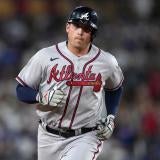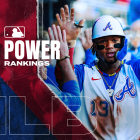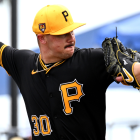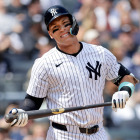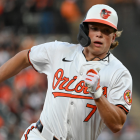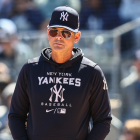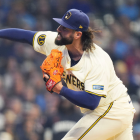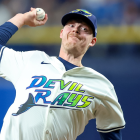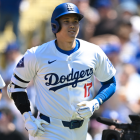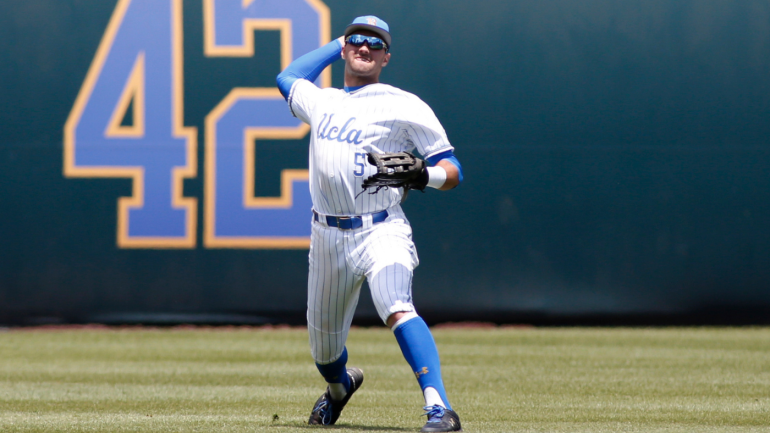
The arrival of the offseason means that it's time to rank stuff. Already this winter, we've sized up the 60 best free agents, both on an overall and positional basis. There's no law that prevents us from ranking minor-league players in addition to their big-league counterparts. As such, we're going to spend the winter evaluating every team's farm system.
The lack of a minor-league season makes that more of a challenge this year. It doesn't help that some teams opted against sharing video and data from their alternate-site camps with the rest of the league. As such, we've opted against overthinking this. Our rankings will essentially be the same as they were last winter with a few changes. First, we'll exclude anyone who graduated by exhausting their rookie eligibility; second, we'll replace them with draftees or other worthy prospects; and third, and lastly, we'll present the information in a new format.
In every article in this series, you'll find a team's top five prospects as well as five others we felt like including, either because of their promise or some other reason. For those top five prospects, you'll find a quick summation of their pros (their saving grace, if one will) and their cons (their fault line), as well as beefier report and our attempt to peg their "likeliest outcome."
These rankings were compiled by talking to industry folks -- scouts, analysts, and other evaluators -- and include a touch of our own evaluative biases. Remember, that this is more of an art than a science, and that the write-ups matter more than the rankings themselves.
Now, let's get on to the top five prospects in the Milwaukee Brewers system.
1. Brice Turang, SS
Age (as of 4/1/2021): 21
Height/Weight: 6-foot, 173 pounds
Acquired: No. 21 pick in the 2019 draft (Santiago High School, California)
Highest level: High-A
Saving grace: Secondary value
Fault line: Power
Scouting report: Turang has a healthy appreciation for walks; he's a heady, above-average baserunner; and he's a legitimate shortstop. That should be enough to grant him a high floor. And yet, his dependency on walks and his lack of power make him an attrition risk. If that sounds silly, it's based on the logic that advanced pitchers will force-feed strikes to hitters they feel are unable to punish their mistakes. Turang would seem to fit that description at present; it's possible, then, that his struggles at High-A (.200/.338/.276) are a preview of things to come.
Likeliest outcome: Second-division shortstop or new Rob Refsnyder
2. Garrett Mitchell, OF
Age (as of 4/1/2021): 22
Height/Weight: 6-foot-3, 215 pounds
Acquired: 20th pick in the 2020 draft (UCLA)
Highest level: NCAA
Saving grace: Speed
Fault line: Power
Scouting report: The Brewers had to feel fortunate that Mitchell slid to them in the draft. He was one of the top college position players available thanks to his near-elite foot speed and center-field defense. Mitchell offers more than a high floor, too. He has above-average raw power, even though it hasn't consistently shown up in-game. The Brewers know a thing or two about helping lanky outfielders tap into their pop; if they can coerce a little more juice from Mitchell's bat over the coming years, he could be their starting center fielder for years to come.
Likeliest outcome: Regular center fielder
3. Tristen Lutz, OF
Age (as of 4/1/2021): 22
Height/Weight: 6-foot-2, 210 pounds
Acquired: 34th pick in the 2017 draft (James W. Martin High School, Texas)
Highest level: High-A
Saving grace: Offensive potential
Fault line: Defensive profile
Scouting report: Lutz is a bat-first prospect with average or better offensive potential thanks to his raw strength and inclination to walk. He's struck out a lot in the lower levels, which makes him an attrition risk. He's also not likely to provide a ton of defensive value, though his strong arm ought to allow him to stick in right field.
Likeliest outcome: Regular right fielder
4. Freddy Zamora, SS
Age (as of 4/1/2021): 22
Height/Weight: 6-foot-1, 190 pounds
Acquired: Second-round pick in the 2020 draft (Miami)
Highest level: NCAA
Saving grace: Well-rounded skill set
Fault line: Lost year
Scouting report: Between the pandemic and a suspension and a knee injury, Zamora did not make a single appearance in 2020. If he had, he likely would've been off the board by the time the Brewers popped him with the 53rd pick. Zamora has an above-average arm and range, and he was a more dynamic offensive player during his collegiate career than Alika Williams -- the Arizona State shortstop who was picked 37th. Zamora carries some additional risk because of the injury, but he there's ample reward here, too.
Likeliest outcome: Starting shortstop
5. Zack Brown, RHP
Age (as of 4/1/2021): 26
Height/Weight: 6-foot-1, 199 pounds
Acquired: Fifth-round pick in the 2016 draft (Kentucky)
Highest level: Triple-A
Saving grace: Forgiveness
Fault line: Atrocious 2019
Scouting report: Brown's 2019 season was horrid: he accumulated a 5.79 ERA and allowed more than a home run and nearly five walks per nine innings in his first 25 Triple-A appearances. He pitched so poorly that the Brewers -- who clearly don't have much of a farm system -- left him unprotected for the Rule 5 draft … and nobody took him; not even the Orioles or Pirates for a spring look. He has an average arsenal and he might end up in the bullpen -- or, perhaps, Triple-A for perpetuity if he doesn't pitch better this upcoming year.
Likeliest outcome: Back-end starter
Five others to know
- Ethan Small, LHP
Small's game is, by and large, based on deception. He gets good extension from an over-the-top release point and he will alter his leg kick to disrupt hitters' timing. He isn't void of stuff, of course. Small has a high-spin fastball and a quality changeup; he just doesn't have the kind of stuff that's likely to allow him to be more than, say, a No. 4 starter at his peak.
- Corey Ray, OF
Ray is never going to live up to his draft status -- he was the No. 5 pick in 2016 -- but he could still have a big-league career if he can get his strikeouts under control. In 2019, he punched out in nearly 40 percent of his 230 plate appearances at the Triple-A level. Ray had previously kept his K rate around the 30 percent threshold. A return to that level would make it more likely that his well-above-average raw power and speed could keep him afloat.
- Aaron Ashby, LHP
Ashby has the potential for an arsenal full of average or better offerings. Unfortunately, his control might force him into a bullpen. He walked more than four batters per nine innings in 2019, and that's before being introduced to Double-A. Ashby manipulates his spine in order to achieve his over-the-top release, suggesting that his command woes might be difficult to tame.
Feliciano is a swing-happy backstop who has a good feel for contact. He, like a number of other Brewers hitting prospects, strikes out more often than you'd like. He also doesn't project to be a high-grade defender. Still, he's a young catcher who hit .270/.323/.473 across two levels in 2019, meaning that you have to be aware of his existence at absolute minimum.
- Payton Henry, C
Henry is an attrition risk based on his sky-high strikeout rate. He's consistently punched out in around 30 percent of his plate appearances -- a rate that could shoot up once he reaches the higher-minors. If, somehow, Henry can continue to make enough contact to avoid falling into the abyss, he could have a future as a slugging backup backstop with a good arm.







